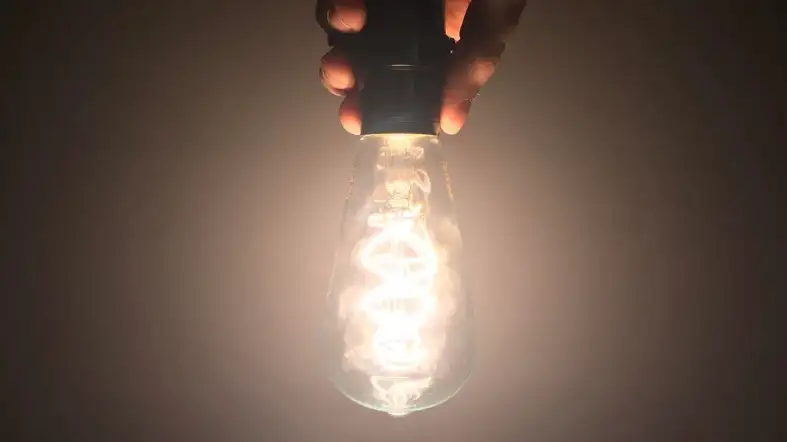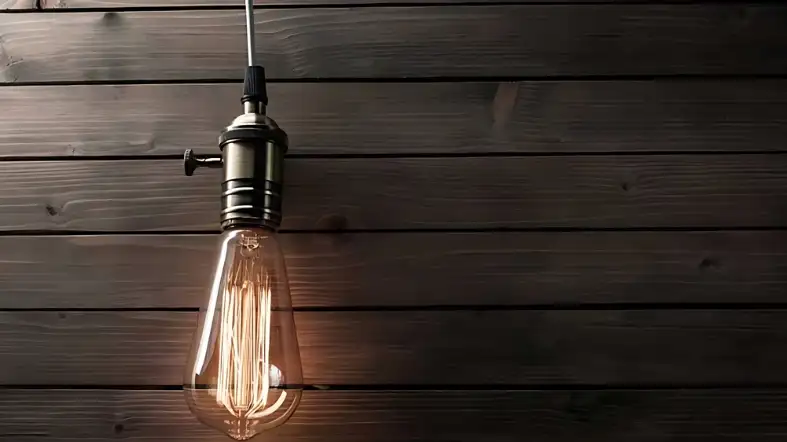Are you tired of those mysterious flickering lights when you switch on your appliances? Wondering why it happens and if it’s a cause for concern?
In this article, we’ll shed light on the common issue of lights flickering when an appliance turns on.
No more puzzling over the phenomenon – we’ve got all the answers you need to understand and resolve this annoying problem.
why Lights Flicker When Appliance Turns On?
Lights flickering when an appliance turns on is caused by a drop in voltage reaching the lighting circuits. The effect is most pronounced with appliances, like refrigerators, air conditioners, or ovens. Checking connections, balancing loads, or separating lights and appliances may help.
Common reasons for Flickering Lights When Appliances Are Turned On

Power Surge
When certain appliances, like refrigerators or air conditioners, start up, they draw a significant amount of power.
This sudden surge in electricity can cause temporary voltage fluctuations, leading to lights flickering for a brief moment.
Circuit Overload
If you have multiple high-power appliances connected to the same circuit, it can exceed the circuit’s capacity.
This overload strains the electrical system, causing lights to flicker as the available power is momentarily stretched thin.
Loose Wiring Connections
Over time, electrical connections can become loose or worn out.
When appliances are turned on, slight movement or vibration can further disrupt these connections, resulting in flickering lights.
Regular inspection and tightening of wiring connections can help alleviate this issue.
Faulty Light Switches
Defective or worn-out light switches can cause flickering when appliances are activated.
If you notice flickering specifically when you flip a particular switch, it might be time to replace it with a new one.
Aging Electrical System
As electrical systems age, they may experience degradation in their overall performance.
Older wiring or outdated components can contribute to flickering lights, especially when appliances demand higher levels of electricity.
Specific Appliances That Are More Likely To Cause Lights To Flicker When Turned On

Air Conditioners
When air conditioners start, they require a significant amount of power. This sudden power draw can cause a temporary strain on the electrical system, leading to flickering lights.
Refrigerators
Refrigerators also consume a substantial amount of energy when their compressors turn on.
The sudden increase in power demand can briefly affect the electrical supply, resulting in lights flickering.
Washing Machines
The motor in a washing machine uses a considerable amount of electricity.
When the motor starts or changes cycles, it can cause a momentary fluctuation in the electrical system, causing lights to flicker.
Dryers
Similar to washing machines, dryers have powerful motors that require a significant amount of energy.
When the dryer starts or the heating element kicks in, it can cause a temporary strain on the electrical system.
Space Heaters
Space heaters consume a substantial amount of electricity to generate heat.
When they are turned on, the sudden demand for power can briefly impact the electrical flow, leading to lights flickering.
Microwaves
Microwaves draw a significant amount of power to operate. When they are turned on, the sudden surge in energy usage can cause a momentary strain on the electrical system, resulting in flickering lights.
Power Tools
High-powered tools such as drills, saws, or welders can greatly load the electrical system.
When these tools are used, they can cause temporary fluctuations in the power supply, leading to lights flickering.
How to Fix Flickering Lights When Appliances Turn On?- Troubleshooting Tips

Check the Appliance
Start by inspecting the appliance causing the flickering. Ensure it is in good working condition, with no loose connections or damaged cords.
If any issues are found, repair or replace the appliance as necessary.
Evaluate the Circuit Load
Next, assess the electrical load on the circuit. If multiple high-power appliances are connected to the same circuit, it can lead to flickering.
Distribute the load by plugging appliances into different circuits or consider upgrading to a higher-capacity circuit.
Tighten Connections
Loose wiring connections can contribute to flickering lights. Safely turn off the power and carefully inspect the wiring connections, tightening any loose ones.
Exercise caution and consult a professional if you’re unsure about handling electrical components.
Upgrade Light Switches
Outdated or faulty light switches can cause flickering. Consider upgrading to modern, high-quality switches that can handle the electrical load.
Consult an electrician for assistance with installation if needed.
Address Electrical System Issues
If the flickering persists, it may indicate underlying electrical system issues. Consult a professional electrician to inspect and evaluate your system.
They can identify any faults, recommend repairs or upgrades, and ensure your electrical system operates safely and efficiently.
Monitor for Improvements
After implementing the troubleshooting steps, monitor your lights for improvements. You’ve successfully resolved the issue if the flickering significantly reduces or disappears.
If not, consult a professional electrician for further investigation.
Potential Risks Associated with Persistent Light Flickering

Persistent light flickering can pose a number of potential risks to your health. They are,
Electrical Overloading: Understanding the Dangers
Persistent light flickering could be indicative of electrical overloading in your home.
Overheating of circuits and wires can result from excessive power drawn from appliances.
This poses a serious fire hazard and could potentially result in electrical fires if not addressed promptly.
Regularly check your circuit breakers and electrical connections to prevent overloading.
Voltage Fluctuations: Unraveling the Impact
Electronic devices can suffer from voltage fluctuations, which often cause the flickering of lights.
Inconsistent voltage levels can damage devices like computers, televisions, and refrigerators.
Surge protectors can prolong the lifespan of your electronics and protect them from harm.
Dimming Light Bulbs: A Sign of Poor Wiring
Dimming light bulbs when an appliance turns on could indicate poor or inadequate wiring. Your appliances will perform less well with faulty wiring, which can lead to electrical shocks.
An electrician can inspect your home’s wiring for safety issues and ensure proper safety measures.
Impact on Appliances: Identifying Potential Damage
Frequent light flickering may negatively impact the performance and longevity of your appliances. It is crucial for air conditioners, refrigerators, and washing machines to have stable electricity.
Flickering lights can strain appliances’ motors and components, resulting in premature wear and tear.
Health Concerns: Addressing Eye Strain and Discomfort
If you work or read under flickering lights for long periods of time, it can cause eye strain and discomfort.
This may lead to headaches, fatigue, and reduced productivity. Make your workspace more comfortable by using LED lights that are less prone to flickering.
Home Safety: Reducing the Risk of Accidents
In addition to electrical hazards, flickering lights can also contribute to accidents in and around your home.
A dimly lit area with flickering lights may make you trip, fall, or bump into objects, particularly at night. Ensure proper illumination in all areas to maintain a safe living environment.
Electrical System Damage: Investigating the Root Causes
Ignoring persistent light flickering can lead to more severe electrical system damage over time.
It might become more complex, requiring expensive and extensive repairs to resolve the underlying issues.
Addressing the root causes early on can save you from potential headaches and financial burdens down the road.
Fire Hazard: Taking Preventive Measures
Perhaps the most critical risk associated with persistent light flickering is the potential for fire hazards.
It is possible for flickering lights to cause electrical faults and spark fires that can spread quickly.
Regularly inspect your electrical system, use high-quality components, and address flickering promptly.
Tips for Preventing Flickering Lights When Appliances Turn On
Spread the Load
Avoid overloading your circuits by distributing the power demand among different outlets and circuits.
Plug high-power appliances into separate circuits to prevent excessive strain on a single circuit, which can lead to flickering lights.
Upgrade Wiring
If your home has outdated or inadequate wiring, consider upgrading to a higher capacity to accommodate modern electrical needs.
Consult a professional electrician for an assessment and necessary improvements to ensure a reliable electrical system.
Check Connections
Loose or faulty electrical connections can contribute to flickering lights. Regularly inspect and tighten wiring connections, ensuring a secure and stable electrical flow.
Remember, always turn off the power before handling any electrical components.
Replace Outdated Switches
Outdated or worn-out light switches can cause flickering. Upgrade to high-quality switches that can handle the electrical load.
A professional electrician can help with the installation if needed.
Utilize Surge Protectors
Protect your appliances from power surges by using surge protectors. These devices help regulate and stabilize the electrical flow,
It minimizes the risk of flickering lights and potential damage to your valuable electronics.
Professional Inspection
Schedule regular inspections by a qualified electrician to assess the overall health of your electrical system.
They can identify any potential issues before they escalate, ensuring the safety and efficiency of your home’s electrical setup.
FAQs about Lights Flicker When the Appliance Turns On
Is It Dangerous If Lights Flicker When An Appliance Turns On?
Occasional flickering is usually harmless.
Consult a professional electrician if flickering persists or is accompanied by other electrical issues.
Are Flickering Lights A Sign Of A Faulty Appliance?
Flickering lights are not always indicative of a faulty appliance.
If you notice consistent flickering when a specific appliance is turned on, it’s worth checking the appliance’s condition.
And next, consult a professional if needed.
Can Using Extension Cords Cause Lights To Flicker?
Extension cords can potentially contribute to flickering if they are overloaded or damaged.
It’s best to use extension cords sparingly and replace any damaged ones to prevent electrical issues.
What Should I Do If Lights Flicker Excessively Or Continuously?
Excessive or continuous flickering may indicate a larger electrical issue.
In such cases, contact a professional electrician to assess and address the underlying problem for proper resolution.
Should I Be Concerned If Lights Only Flicker Occasionally?
Occasional flickering, especially during appliance start-up, is typically normal.
If the frequency or intensity of flickering increases, it may be worth investigating further.
So you can rest assured that everything is functioning as it should.
Final Words
Ready to put an end to those flickering lights when your appliances kick into action?
By understanding the causes behind this phenomenon and following the troubleshooting tips provided, you have the power to enjoy a stable and flicker-free lighting experience in your home.
Take control of your electrical system, eliminate the mystery, and say goodbye to those bothersome flickers.

